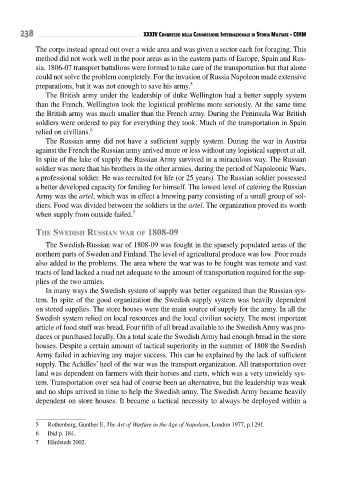Page 238 - Conflitti Militari e Popolazioni Civili - Tomo I
P. 238
238 XXXIV Congresso della CommIssIone InternazIonale dI storIa mIlItare • CIHm
The corps instead spread out over a wide area and was given a sector each for foraging. This
method did not work well in the poor areas as in the eastern parts of Europe, Spain and Rus-
sia. 1806-07 transport battalions were formed to take care of the transportation but that alone
could not solve the problem completely. For the invasion of Russia Napoleon made extensive
5
preparations, but it was not enough to save his army.
The British army under the leadership of duke Wellington had a better supply system
than the French. Wellington took the logistical problems more seriously. At the same time
the British army was much smaller than the French army. During the Peninsula War British
soldiers were ordered to pay for everything they took. Much of the transportation in Spain
relied on civilians. 6
The Russian army did not have a sufficient supply system. During the war in Austria
against the French the Russian army arrived more or less without any logistical support at all.
In spite of the lake of supply the Russian Army survived in a miraculous way. The Russian
soldier was more than his brothers in the other armies, during the period of Napoleonic Wars,
a professional soldier. He was recruited for life (or 25 years). The Russian soldier possessed
a better developed capacity for fending for himself. The lowest level of catering the Russian
Army was the artel, which was in effect a brewing party consisting of a small group of sol-
diers. Food was divided between the soldiers in the artel. the organization proved its worth
when supply from outside failed. 7
the swedish russian war Of 1808-09
The Swedish-Russian war of 1808-09 was fought in the sparsely populated areas of the
northern parts of Sweden and Finland. The level of agricultural produce was low. Poor roads
also added to the problems. The area where the war was to be fought was remote and vast
tracts of land lacked a road net adequate to the amount of transportation required for the sup-
plies of the two armies.
In many ways the Swedish system of supply was better organized than the Russian sys-
tem. In spite of the good organization the Swedish supply system was heavily dependent
on stored supplies. The store houses were the main source of supply for the army. In all the
Swedish system relied on local resources and the local civilian society. The most important
article of food stuff was bread. Four fifth of all bread available to the Swedish Army was pro-
duces or purchased locally. On a total scale the Swedish Army had enough bread in the store
houses. Despite a certain amount of tactical superiority in the summer of 1808 the Swedish
Army failed in achieving any major success. This can be explained by the lack of sufficient
supply. The Achilles’ heel of the war was the transport organization. All transportation over
land was dependent on farmers with their horses and carts, which was a very unwieldy sys-
tem. Transportation over sea had of course been an alternative, but the leadership was weak
and no ships arrived in time to help the Swedish army. The Swedish Army became heavily
dependent on store houses. It became a tactical necessity to always be deployed within a
5 Rothenberg, Gunther E, The Art of Warfare in the Age of Napoleon, London 1977, p.129f.
6 Ibid p. 184.
7 Hårdstedt 2002.

